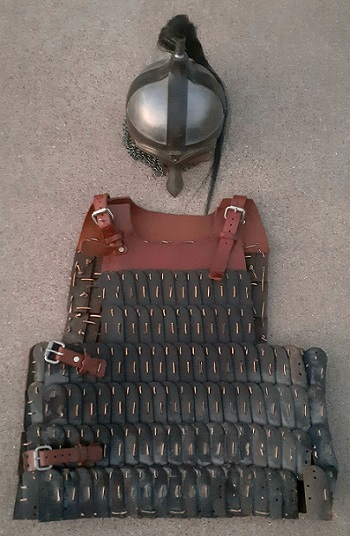Subject: hadnagy noble cavalryman
Culture: Magyar
Setting: European migration, Carpathian Basin late 9th-10thc
Evolution:
Context (Event Photos, Primary Sources, Secondary Sources, Field Notes)
* Nicolle/McBride 1984 p24-25
"The Magyars were an amalgamation of various Finno-Ugrian and Turkish tribes who, driven from their lands in southern Russia and apparently losing most of their womenfolk in the process, conquered and settled what is now known as Hungary in the last years of the 9th century. Though their culture was nomadic, the Magyars were by no means barbarians. Some were probably Christian, others were Jews. Their aristocracy was essentially Turkish and their art, their craftsmanship and above all their weaponry were superb. The Magyars, despite their misfortunes and migrations, kept in close trading contact not only with Byzantium but also with the sophisticated eastern provinces of Islam. It has, in fact, been suggested that the Magyar aristocracy was at this period culturally akin to that of Islamic Iran -- though not, of course, being Muslim.
* Bennett 1998 p199
"Magyars according to legend, the nomadic Magyars, the invaders and creators of Hungary, were made up of nine tribes, but were heterogeneous like many Eurasian nomadic groups. They were mobile horse-archers and devastated Europe on deep raids from their base on the Hungarian steppe between 898 and 955. They were defeated by the Holy Roman emperor Otto I in 955. After 1000 they converted to Christianity and became valuable allies to the crusaders."
Armor
* Nicolle/McBride 1984 p25
"Compared to their late Carolingian enemies the Magyars possessed very little armour. As is normal in such nomadic tribal societies only an aristocratic élite wore metal armour, the rest relying on heavy felt coats and perhaps leather lamellar for protection. On the other hand this aristocratic armour was of particularly fine quality, according to Russian, Byzantine and Islamic sources. Magyar lamellar almost certainly influenced that of Scandinavia and probably that of the eastern Slavs as well. Shields rarely seem to have been used."
Costume
* Imperial style 1980 p75 (Katalin Földi-Dózsa, "How the Hungarian national costume evolved" p74-87)
"There are no images of these ancient people; only through asides in the histories of other ancient tribes and through the remains in their graves do we have any conception of the way they lived. They apparently dressed like eastern horsemen -- much the way modern nomads in the Middle and Far East still do. The most important item of their clothing was a knee-length caftan with a stand-up collar and a slit opening in the front that was either laced closed or fastened with buttons.
* Gorelik 1995 p18
"The Magyars were friendly with the Khazars and embraced numerous elements of their culture, including warcraft, yet conserved their own quite impressive traditions showing a strong Central Asian influence. Their heavy cavalry was akin to that of the Khazars, Bulgarians and Alanians, but looked smarter and more 'Asiatic'."
* Nicolle/McBride 1984 p38-39 (reconstructing a Magyar nobleman, first half 10th century)
"The way of life of the Magyar warrior aristocracy was similar to that of the Iranian nobility; certainly their equipment had the same Central Asian origins. This man's segmented spangenhelm, sabre and bow are in this tradition. ... The double-breasted felt coat is fastened right across under the left arm. He wears Asian-style fur-lined boots without heels, whose legs button down the outside, the exposed edge cut to a decorative shape; and silver prick-spurs."
Bow
* Nicolle/McBride 1984 p25
"The bow was the Magyar's most effective weapon. This was of a composite type similar to the earlier Hun bow and much straighter in outline than that of the Magyars' Avar predecessors."
Saber
* Nicolle/McBride 1984 p26
"[A] typically Central Asian curved sabre ... was known to the Christians as a gladius hunnicus or Hunnish sword. Magyar sabres were characterised by curved hilts and down-turned quillons."
Belt
* Imperial style 1980 p75 (Katalin Földi-Dózsa, "How the Hungarian national costume evolved" p74-87)
"The most impressive item in the Magyar costume was an elaborate leather belt laden with gold and stamped silver. It not only held together their loose garments but was also a place to carry valuables: eastern-style bent blades, gold-encrusted cartridge cases, bow cases, and fire iron were all hung from the belt. The belt itself was lavishly decorated with metal plates suspended from leather straps. When a man walked, these ornaments -- and his assorted possessions -- clanged together. To further enhance their dazzling appearance, the ancient Magyars wore opulent rings and earrings; brooches and buttons were finely made by their nomadic goldsmiths."
